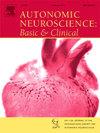Orthostatic cardiovascular responses to postural sway and discreet counterpressure maneuvers
IF 3.3
4区 医学
Q2 NEUROSCIENCES
引用次数: 0
Abstract
Counterpressure maneuvers (CPM) are movements used to delay or abort syncope, but may have practical barriers to use. We recently showed exaggerated postural sway produces protective responses against syncope. Accordingly, we aimed to evaluate a series of discreet, accessible movements as novel preventative CPM.
We tested 26 healthy adults (12 female) aged 28.9 ± 1.2 years. Participants performed a baseline stand (BL), followed by three randomized CPM trials (exaggerated anteroposterior sway, AP; toe clenching, TC; gluteal muscle clenching, GC). Non-invasive beat-to-beat systolic arterial pressure (SAP), heart rate, stroke volume (SV), cardiac output (CO), total peripheral resistance (TPR), mean middle cerebral artery blood velocity (mMCAv), and total path length moved (TPL) were measured. Muscularity was assessed using bioelectrical impedance.
All discreet CPM augmented orthostatic SV (p < 0.001) and CO (p < 0.001), while reducing TPR (p < 0.001). SAP increased during AP (p < 0.001) and GC (p < 0.001), but not TC. GC responses were unstable, with increased standard deviation of SAP (p = 0.002) and SV (p = 0.022) that may predispose syncope. Only AP improved mMCAv (p = 0.005) and sympathovagal balance (p < 0.001). Responses were largest in those with greater initial cardiovascular instability (p < 0.003), larger leg muscle mass (p < 0.02), and where TPL was greater (p < 0.002).
These novel CPM hold clinical potential for the prevention of orthostatic syncope and presyncope, while addressing real-world patient-reported barriers to CPM. Exaggerated AP sway was most robust and stable at improving orthostatic hemodynamics in healthy controls, with reduced reliance on sympathetic baroreflex-mediated vasoconstriction during enhanced muscle pumping activity. Accordingly, AP shows the most promise as a simple and discrete CPM.

直立心血管对姿势摇摆和谨慎的反压动作的反应
反压动作(CPM)是用来延缓或中止晕厥的动作,但可能有实际的障碍。我们最近发现过度的姿势摇摆可以产生防止晕厥的保护性反应。因此,我们的目标是评估一系列谨慎的、可接近的运动作为新的预防性CPM。健康成人26例,其中女性12例,年龄28.9±1.2岁。参与者进行了基线站立(BL),随后进行了三个随机CPM试验(夸张的前后摇摆,AP;脚趾握紧,TC;臀肌握紧(GC)。测量无创搏动收缩压(SAP)、心率、每搏量(SV)、心输出量(CO)、总外周阻力(TPR)、平均大脑中动脉血流速度(mMCAv)和总路径移动长度(TPL)。采用生物电阻抗法评估肌肉强度。全离散CPM增强直立SV (p <;0.001)和CO (p <;0.001),同时降低TPR (p <;0.001)。AP期间SAP升高(p <;0.001)和GC (p <;0.001),但不是TC。GC反应不稳定,SAP (p = 0.002)和SV (p = 0.022)的标准差增加可能导致晕厥。只有AP能改善mMCAv (p = 0.005)和交感迷走神经平衡(p <;0.001)。在初始心血管不稳定程度较高的患者中反应最大(p <;0.003),腿部肌肉质量较大(p <;0.02), TPL更大(p <;0.002)。这些新型CPM具有预防直立性晕厥和晕厥前期的临床潜力,同时解决了现实世界中患者报告的CPM障碍。在健康对照中,过度的AP摆动在改善直立血流动力学方面是最稳健和稳定的,在增强的肌肉泵送活动中,对交感压力反射介导的血管收缩的依赖减少。因此,AP作为一种简单而离散的CPM显示出最大的前景。
本文章由计算机程序翻译,如有差异,请以英文原文为准。
求助全文
约1分钟内获得全文
求助全文
来源期刊
CiteScore
5.80
自引率
7.40%
发文量
83
审稿时长
66 days
期刊介绍:
This is an international journal with broad coverage of all aspects of the autonomic nervous system in man and animals. The main areas of interest include the innervation of blood vessels and viscera, autonomic ganglia, efferent and afferent autonomic pathways, and autonomic nuclei and pathways in the central nervous system.
The Editors will consider papers that deal with any aspect of the autonomic nervous system, including structure, physiology, pharmacology, biochemistry, development, evolution, ageing, behavioural aspects, integrative role and influence on emotional and physical states of the body. Interdisciplinary studies will be encouraged. Studies dealing with human pathology will be also welcome.

 求助内容:
求助内容: 应助结果提醒方式:
应助结果提醒方式:


